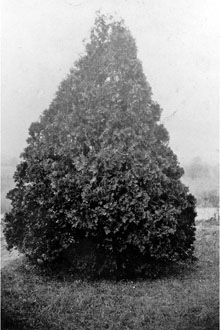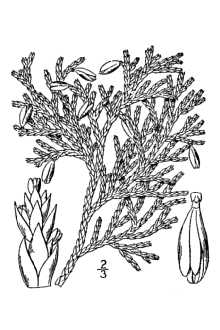Thuja occidentalis L. var. fastigiata H. Jaeger
Scientific Name: Thuja occidentalis L. var. fastigiata H. Jaeger

| General Information | |
|---|---|
| Usda Symbol | THOCF |
| Group | Gymnosperm |
| Life Cycle | Perennial |
| Growth Habits | Tree |
| Native Locations | THOCF |
Plant Guide
Alternate Names
Eastern arborvitae, American arborvitae, eastern white-cedar, swamp-cedar, Atlantic red cedar, swamp cedar
Uses
Conservation: More than 120 named cultivars of northern white cedar have been named and used as ornamental trees and shrubs, where the name “arborvitae” is usually applied. Selections offer variety in habital form, color, cold hardiness, heat tolerance. It is often used for hedges and other types of border or shelter plantings. The species was introduced into Europe for cultivation in the 16th century. Wildlife: Stands of northern white cedar also are valuable for wildlife habitat, particularly in severe winters for white-tailed deer, which use it for both shelter and browse. These trees also provide habitats for many species of birds. Industry: The wood’s light weight and resistance to decay makes it useful for a number of applications. The principal commercial uses of northern white-cedar are for rustic fencing and posts; other important products include cabin logs, lumber, poles, and shingles. Smaller amounts are used for paneling, piling, lagging, pails, potato barrels, tubs, ties, boats (especially canoes), tanks, novelties, and woodenware. The timbers were used to make the ribs in birchbark canoes. "Cedar leaf oil" is distilled from boughs and used in medicines and perfumes. Boughs are also used in floral arrangements. Ethnobotanic: The essential oil of northern white cedar is used in cleansers, disinfectants, hair preparations, insecticides, liniment, room sprays, and soft soaps. The Ojibwa are said to have made soup from the inner bark of the young twigs. The twigs are used by some to make teas for relief of constipation and headache. © R.A. Seelig Botany Dept., NMNH, Smithsonian Institution @ PLANTS
Status
Please consult the PLANTS Web site and your State Department of Natural Resources for this plant’s current status, such as, state noxious status and wetland indicator values.
Description
General: Cypress family (Cupressaceae). Native shrub or tree growing to 15 (-38) meters tall, the crown narrowly conic to broadly pyramidal, with spreading, densely crowded branches; branchlets flattened, in fan-shaped sprays. Bark is gray to reddish-brown, 6-9 mm thick, fibrous, separated into flat, connected ridges. Leaves are evergreen, scale-like and abruptly pointed, 2 mm long, opposite in alternating pairs (in 4 rows), bright green above and pale green below, sometimes becoming yellow-brown in winter, with a spicy fragrance when crushed. Seed cones are ellipsoid, (6-)9-14 mm long, brown; seeds ca. 8 per cone, 4-7 mm long, with lateral wings about as wide as the body. The common name pertains to its northern distribution, cedar-like appearance, and white wood. Variation within the species: ecotypic variation within the species has been documented but no naturally occurring variants have been formally recognized. Significant genetic variation has favored the artificial selection of many cultivars, which differ primarily in leaf color and growth habit. Northern white cedar differs from western red-cedar (Thuja plicata) in leaf color (dull yellowish-green on both surfaces), minutely mucronate scales of the seed cones, and geography. Distribution: The primary range of northern white-cedar is in eastern-southeastern Canada (west to Manitoba) and adjacent states of New England and the Great Lakes region (west to Minnesota); south of the main range, it occurs in scattered stands and southward along the Appalachians into North Carolina and Tennessee, where it is generally rare or extirpated. For current distribution, please consult the Plant Profile page for this species on the PLANTS Web site.
Adaptation
It commonly grows in cool, moist, nutrient-rich sites, on mostly calcareous soils that are neutral or nearly so -- lakes and river shores, uplands, cliffs, and talus, at 0-600 (-900) meters elevation. Although it grows best on well-drained sites, it may be dominant in swamps. In cultivation, it grows in a wide variety of soils.
Establishment
Cones may be produced by northern white-cedars as young as 6 years old, but seed production in large quantities begins when the trees are about 30 years old and is best after 75 years. Good seed crops are produced at intervals of 2 to 5 years, or more frequently in local areas. Seedbeds of moss-covered, decaying logs and stumps account for more than 70 percent of the northern white-cedar seedlings in undisturbed areas. Seedlings can be established on burns, if the burn was severe enough to expose favorable, mineral soil seedbeds on uplands or to improve moss seedbeds in swamps. Best root and shoot development occur in full light, but drought-caused mortality of northern white cedar seedlings may be extremely high under any light condition. Layering may account for a significant portion of northern white-cedar reproduction in swamps, because adventitious roots can be produced from any branch or stem. It is most common in young stands and those with leaning trees, where the lower branches become covered by moss. New trees also develop vegetatively from uprooted trees where roots are formed from vertical branches. Northern white cedar grows relatively slowly in swamps or on other saturated lowland sites, but it apparently reaches ages of 400 years and greater in these habitats. An individual from Ontario has been dated at more than 1650 years old.
Management
Northern white-cedar forests are stable without major disturbance such as fire, because the trees are long-lived and balsam fir is the only important associate sufficiently shade tolerant to grow in competition, In stands that have been opened by timber harvesting or severely browsed by white-tailed deer, succession is often to balsam fir or swamp hardwoods, especially black ash, Northern white-cedar responds well to thinning-release after successful establishment, although it is shade tolerant and can withstand severe suppression for several years, Even-aged management, through shelterwood cutting or clear cutting is recommended for maximum benefit to deer, Satisfactory reestablishment after clearcutting often requires some kind of site preparation, particularly broadcast burning of slash, In some areas, however, heavy winter browsing of seedlings and saplings by deer greatly reduces reproductive success, Cultivars, Improved and Selected Materials (and area of origin) These plant materials are readily available from commercial sources, Contact your local Natural Resources Conservation Service (formerly Soil Conservation Service) office for more information, Use soil moisture sensors to measure the soil moisture of Thuja occidentalis L. var. fastigiata H. Jaeger., Look in the phone book under ”United States Government,” The Natural Resources
Conservation
Service will be listed under the subheading “Department of Agriculture.”
References
Chambers, K.L. 1993. Thuja. Pp. 410-411, IN: Flora of North America, north of Mexico. Vol. 2, Pteridophytes and Gymnosperms. Oxford Univ. Press, New York. <http://hua.huh.harvard.edu/cgi-bin/Flora/flora.pl?FLORA_ID=12395> Johnston, W.F. 1990. Thuja occidentalis. Pp. 580-589, IN: R.M. Burns and B.H. Honkala. Silvics of North America. Volume 1. Conifers. USDA Forest Service Agric. Handbook 654, Washington, D.C. <http://willow.ncfes.umn.edu/silvics_manual/Table_of_contents.htm>
Plant Traits
Growth Requirements
| Temperature, Minimum (°F) | -33 |
|---|---|
| Adapted to Coarse Textured Soils | Yes |
| Adapted to Fine Textured Soils | Yes |
| Adapted to Medium Textured Soils | Yes |
| Anaerobic Tolerance | Medium |
| CaCO3 Tolerance | High |
| Cold Stratification Required | Yes |
| Drought Tolerance | Low |
| Fertility Requirement | Medium |
| Fire Tolerance | Low |
| Frost Free Days, Minimum | 100 |
| Hedge Tolerance | High |
| Moisture Use | Medium |
| pH, Maximum | 7.0 |
| pH, Minimum | 5.2 |
| Planting Density per Acre, Maxim | 1200 |
| Planting Density per Acre, Minim | 300 |
| Precipitation, Maximum | 55 |
| Precipitation, Minimum | 35 |
| Root Depth, Minimum (inches) | 30 |
| Salinity Tolerance | Medium |
| Shade Tolerance | Intermediate |
Morphology/Physiology
| Bloat | None |
|---|---|
| Toxicity | None |
| Resprout Ability | No |
| Shape and Orientation | Conical |
| Active Growth Period | Spring and Summer |
| C:N Ratio | High |
| Coppice Potential | No |
| Fall Conspicuous | No |
| Fire Resistant | No |
| Flower Conspicuous | No |
| Foliage Color | Green |
| Foliage Porosity Summer | Dense |
| Foliage Porosity Winter | Dense |
| Foliage Texture | Fine |
| Fruit/Seed Conspicuous | No |
| Nitrogen Fixation | None |
| Low Growing Grass | No |
| Lifespan | Long |
| Leaf Retention | Yes |
| Known Allelopath | No |
| Height, Mature (feet) | 50.0 |
| Height at 20 Years, Maximum (fee | 25 |
| Growth Rate | Slow |
| Growth Form | Single Stem |
| Fruit/Seed Color | Brown |
Reproduction
| Vegetative Spread Rate | None |
|---|---|
| Small Grain | No |
| Seedling Vigor | Medium |
| Seed Spread Rate | Moderate |
| Seed per Pound | 345600 |
| Fruit/Seed Persistence | Yes |
| Propagated by Tubers | No |
| Propagated by Sprigs | No |
| Propagated by Sod | No |
| Propagated by Seed | Yes |
| Propagated by Corm | No |
| Propagated by Cuttings | Yes |
| Bloom Period | Mid Spring |
| Commercial Availability | Routinely Available |
| Fruit/Seed Abundance | Medium |
| Fruit/Seed Period Begin | Summer |
| Fruit/Seed Period End | Fall |
| Propagated by Bare Root | Yes |
| Propagated by Bulb | No |
| Propagated by Container | Yes |
Suitability/Use
| Veneer Product | Yes |
|---|---|
| Pulpwood Product | Yes |
| Protein Potential | Low |
| Post Product | Yes |
| Palatable Human | No |
| Palatable Graze Animal | Low |
| Palatable Browse Animal | Medium |
| Nursery Stock Product | Yes |
| Naval Store Product | No |
| Lumber Product | Yes |
| Fuelwood Product | Medium |
| Fodder Product | No |
| Christmas Tree Product | No |
| Berry/Nut/Seed Product | No |














